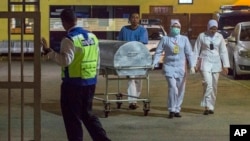A paranoid dictator’s estranged brother. Two young female assassins. A crowded international airport. And a mysterious poison that kills within hours.
It’s the perfect recipe for a thrilling cloak-and-dagger spy novel. Except some, or possibly even all, of this tale could be true in the apparent assassination of Kim Jong Nam, the older half brother of reclusive North Korean leader Kim Jong Un. And just like similar intriguing cases from the past, the public is hanging on every detail because there’s just something about murder by poison that captivates.
“A gun announces its mischief; poison can sneak in with a sip of champagne,” said Robert Thompson, a pop culture expert at Syracuse University. “The question isn’t why we are fascinated with this latest story, it’s why wouldn’t we be?”
Still, speculation that Kim Jong Nam was killed by two young female “agents” at the busy Kuala Lumpur airport last week left even the most seasoned toxicology sleuths shaking their heads. Add in that the portly sibling was apparently sprayed in the face with a substance so potent it killed him before he could reach the hospital, and you’ve got a scene straight out of a James Bond movie.
Four people, including the two women — one Indonesian and the other traveling on a Vietnamese passport — have been detained.
The Indonesian told authorities she thought she was participating in a comedy show prank.
Theories and speculation
Conspiracy theories and speculation abound as police scramble to unravel what really happened to Kim Jong Nam, age 45 or 46, the son of late North Korean leader Kim Jong Il and a mistress. After falling out of favor with the family, the son lived for years in exile and was about to catch a flight to Macau when the attack took place. He sought help at the airport clinic after suddenly falling ill and died en route to the hospital. Autopsy results have not been released.
If a chemical agent really was to blame, finding it may be the hardest part of all. Tissue and fluid samples may need to be sent abroad for analysis at a facility with greater capabilities, such as in Japan or at the FBI’s crime lab, if Malaysian experts cannot pinpoint the cause of death.
“The more unusual, the more potent, the more volatile a poison is, the less likely it is to be detected,” said Olif Drummer, a toxicologist at Australia’s Victorian Institute of Forensic Medicine who has spent 40 years in the field.
Such a poison not easy to make, experts say
Experts routinely tasked with finding answers in poisoning cases say the events at Kuala Lumpur’s airline terminal are bizarre, but not impossible.
They wonder: What substance could have been used to kill the victim so quickly without sickening the women who apparently deployed it, along with anyone else nearby? Difficult, they say, but doable.
“It’s not an agent that could be cooked up in a hotel room. It’s going to take a lot of knowledge regarding the chemical in order to facilitate an attack like this,” said Bruce Goldberger, a leading toxicologist who heads the forensic medicine division at the University of Florida.
He said a nerve gas or ricin, a deadly substance found in castor beans, could be possible. A strong opioid compound could also have been used, though that would likely have incapacitated the victim immediately.
“It would have to be cleverly designed in order to be applied in this fashion without hurting anyone else,” Goldberger said.
Poison more common than thought
History is filled with poisoners. From jilted lovers seeking revenge to greedy spouses looking to collect on life insurance policies. Arsenic, cyanide and strychnine are often the toxins of choice used in murders, but political hits are usually a much more complicated business.
“To me, murder by poison is the easiest thing to get away with,” said John Trestrail, a forensic toxicologist who has examined more than 1,000 poisoning crimes. “If all those people in the cemetery who have been poisoned could raise their hands, we’d probably be shocked.”
While murder using toxins is far less common than stabbings and shootings, he said his research shows that poisoners often strike more than once.
“These people get away with it time and time again until somebody says, `Well, hell, she’s had four husbands and they all died suddenly,”’ Trestrail said. “Then the exhumations come and: Bingo!”










